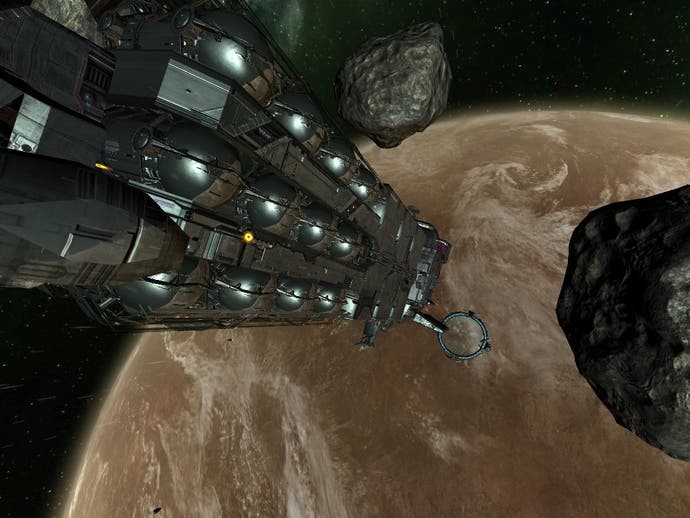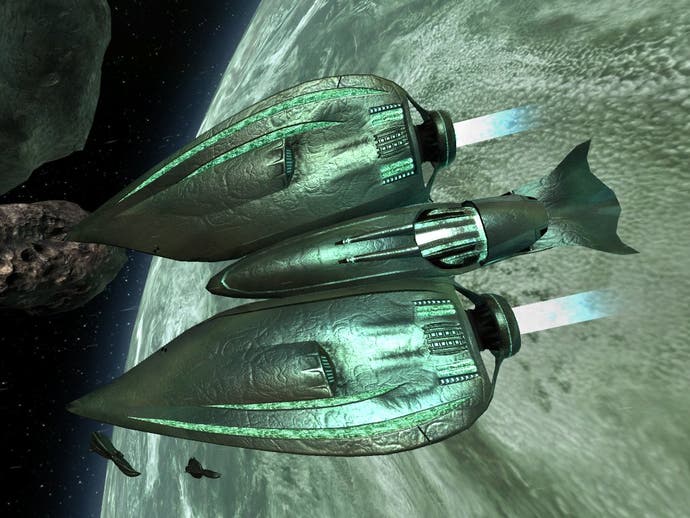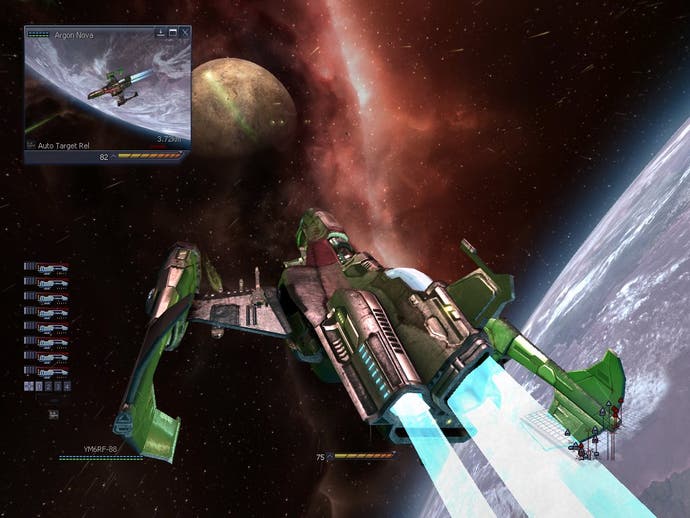X3: Reunion
Lots of space, precious little pace.
Ah, the games industry, such a sweet, mad, baffling creature. Big complicated space sims obviously need to ship with fat manuals or loads of in-game tutorials so what do Deep Silver and Egosoft include with theirs? A 350-page sci-fi novel and no tutorials whatsoever. Nice one, guys.
To be fair there is a small printed manual (85 helpful pages) and there are occasional pop-up advice windows but still, the lack of guidance verges on the scandalous. The pity of it is that many players new to this impressive, ambitious series may well give up after an evening or two of head-scratching, missing out on an engrossing experience.
Just in case you're unaware of X3's father and grandfather, this is an Elite-like freeform space entertainment in which you trade, fight, and construct your way to galactic greatness. There is a plot but it's one you can opt out of any point. There is a ranking system similar to an RPG level ladder but there are no hard-and-fast character classes so every activity is open to every avatar.
The Merchant of Venus

As in all freedom-based games, X3's success depends a lot on the richness and size of its play environment and the variety of activities available within that environment. Although you can't visit planets outside of the plot missions and the range of quest-style one-off jobs offered by NPCs is a bit on the slim side, there is a ton of stuff to do and lots of bustling interesting space to do it in. One of the most important things you can devote time to is trade. Egosoft has created an amazing 'living' economy involving AI merchants, dozens of different commodities and factory types, and prices that alter to reflect levels of supply and demand. By tramping around the game's 130 sectors (uncharted at the start) buying low and selling high you can, if you've got a lot of patience and skill, eventually build-up enough credits to get into factory building. A solar power station here, a bakery or weapons factory there, and before you know it you're running massive self-sufficient industrial networks that span several solar systems.
Don't see yourself as an interplanetary industrialist? Well, how about being a metaphorical tapeworm in the gut of an interplanetary industrialist? Piracy is X3's most exciting occupation but plays havoc with your race rankings (how players are regarded by the eight game races is crucial to trade) and your relationship with the ever-vigilant forces of law and order. If buccaneering sounds too confrontational, there's always contraband-running (folk will always need their space weed and their slaves), asteroid-mining or salvage. Spend enough time wandering around sector edges and exploring asteroid fields and generally you stumble on the odd Marie Celeste or Mary Rose that can be traded-in or repaired.
Shapely ships

Ships come in hundreds of different shapes and sizes and are, almost without exception, works of art. From the tiny single-seat runabouts to the mile-long freighters with their gleaming ventral cargo pods, and the giant carriers with bellies crammed with sleek fighters, everything looks like it's been made for a big budget sci-fi movie rather than a modestly funded PC game. Everything can be owned and flown too. True, there are no cockpits - only first-person perspective forward views. This omission drains some character from the flying experience, especially as the HUD design is identical whether you're at the controls of a standard Argon interceptor or some bizarre-but-beautiful Boron cucumber.
Customising ships is an important part of the game. Until you've fitted a mineral scanner, a drill and an ore-Hoover your craft isn't going to be much good as a mining tool. A privateer that hasn't invested in an engine tune-up, shield upgrades, new missiles systems, and a freight scanner won't be taken seriously in scum sectors like Farnham's Legend and Danna's Chance. There are no orbiting paint-shops allowing pilots to customise liveries, but otherwise there are few aspects of craft you can't fiddle with.
The strafe drive - one available upgrade - shows off very nicely the new 'semi-Newtonian' flight behaviour. Though not as pronounced an effect as it was in games like I-War 2, ships now don't turn as if they were running on rails; they drift allowing natty pivots and power-slides. The extra aerobatic possibilities improve X2's less-than-brilliant dogfighting significantly, as does the introduction of new missile types, slower shield recharging, and a vastly improved targeting system.
Engine trouble

The last X title was a bit of a sloth in the performance department and, sadly, this episode keeps up the ignoble tradition. A lot of the worst slow-down (highly populated sectors can really crawl) seems to be linked to the HUD display which does mean it may be something that can be alleviated in a future patch. Right now, if you intend to run the game on rig anywhere near the minimum spec then expect frame-rates to drop into the teens and below on occasions. In the circumstances, a few more graphics settings options would have been nice.
Along with the poor performance and the unnecessarily steep learning curve, the worst accusation that you can level at X3 is that some of its features seem to have come directly from its predecessor. The most discouraging examples of recycling are the NPC quests advertised on the trading station bulletin boards. The majority of these appear to be X2 vintage. Not a problem if you're new to the series but veterans have every right to grumble.
X3 is a game that takes its time and demands a lot from you. If you're looking for a pacey polished space adventure where you never have to refer to the manual or post a query on the official forum then you're almost certainly better off with something like Freelancer. Bolder souls, as interested in commerce as they are in combat, can buy with much greater confidence.
